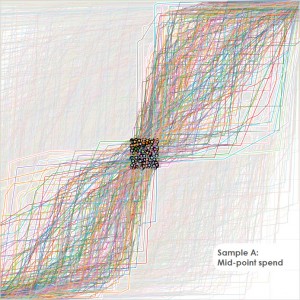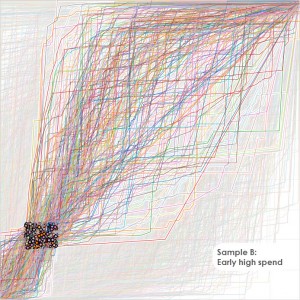
Is the S-Curve a myth?
CEO of Enstoa
The future project organization is data-driven and will innovate new ways of planning and forecasting. It is large collections of data – e.g “Big Data” – and decision making software that will enable this new way of working.
At Enstoa we're always looking at ways data can enhance strategy, planning, and forecasting. Recently we analyzed over 2,200 real construction projects in the U.S. to test the theoretical S-Curve spending pattern. We wanted to know if the S-Curve is a reliable cash flow forecasting tool or a liability. As you’ll see below, we concluded it is a bit of both: helpful and harmful.
The Analysis
Project data were collected across several serial builders – owner organizations with continuous construction programs. We focused on projects less than US $20 million to narrow the range. The image below is our “Cash Flow Quilt” and shows spending patterns for these projects. Schedule (start to finish) is on the x-axis; Spend ($0 to total) is on the y-axis. All projects in the analysis were completed within the last 10 years.
The Results

With a large enough data set we see what appears to be an unlimited number of outcomes for cash flow on projects. There are projects that spend on the upper-outer range, the lower-outer range, and everything in between. “Sample A” has about 250 projects and shows the project mid-point that is half finished, half spent. The data show an infinite number of ways to get to the mid-point and infinite paths from the mid-point to the finish line. “Sample B” also has about 250 projects in an early-high-spend state. We see there again an almost random set of cash flow outcomes for projects that had a higher spend earlier in the project.

This exercise highlights how critical data are in the decision making process. In Sample B, project managers experiencing a high spend relative to the project baseline need data to keep the forecast honest. Using data in these situations minimizes biases that we all carry with us into our decision making processes. In some cases, there may be so much uncertainty in a project that it is unwise to establish a forecast without a wide margin of error expectation. We saw some of those cases throughout our analysis.
We need data to challenge our decisions and force us to think about alternative outcomes and strategies. As managers, we can override the data based on experience and intuition, but we still need it as a sanity check.
What does all this mean for me?
Is the S-Curve cash flow spending pattern a useful tool for forecasting? It is and it isn’t. What is useful is that construction projects typically do spend on an S-Curve and unless a project experiences unique circumstances we can expect the forecast to hold reasonably well. What isn’t useful is when planners use the S-Curve as a go-to forecasting tool without consulting data and analyzing the broad range of potential outcomes. What works in the lab seldom works in the field and the S-Curve model can wed planners to a way of thinking often disproved in the real world.
We recommend project teams begin collecting large data sets on historical project performance. Then, when creating a cash flow forecast for a project, the team can consult the historical database and produce a spending algorithm based on similar projects and contracting strategies. This brings real-world data into the planning process and decreases execution risk by limiting the range of probable outcomes.
Project controls professionals of the future will bring data into decision making. They will challenge colleagues, stakeholders, and suppliers with questions like, “What data do you have to support that strategy?” In short, big data is the new partner in decision making and forecasting.
The future project organization is data-driven and will innovate new ways of planning and forecasting. It is large collections of data – e.g “Big Data” – and decision making software that will enable this new way of working.
At Enstoa we're always looking at ways data can enhance strategy, planning, and forecasting. Recently we analyzed over 2,200 real construction projects in the U.S. to test the theoretical S-Curve spending pattern. We wanted to know if the S-Curve is a reliable cash flow forecasting tool or a liability. As you’ll see below, we concluded it is a bit of both: helpful and harmful.
The Analysis
Project data were collected across several serial builders – owner organizations with continuous construction programs. We focused on projects less than US $20 million to narrow the range. The image below is our “Cash Flow Quilt” and shows spending patterns for these projects. Schedule (start to finish) is on the x-axis; Spend ($0 to total) is on the y-axis. All projects in the analysis were completed within the last 10 years.
The Results

With a large enough data set we see what appears to be an unlimited number of outcomes for cash flow on projects. There are projects that spend on the upper-outer range, the lower-outer range, and everything in between. “Sample A” has about 250 projects and shows the project mid-point that is half finished, half spent. The data show an infinite number of ways to get to the mid-point and infinite paths from the mid-point to the finish line. “Sample B” also has about 250 projects in an early-high-spend state. We see there again an almost random set of cash flow outcomes for projects that had a higher spend earlier in the project.

This exercise highlights how critical data are in the decision making process. In Sample B, project managers experiencing a high spend relative to the project baseline need data to keep the forecast honest. Using data in these situations minimizes biases that we all carry with us into our decision making processes. In some cases, there may be so much uncertainty in a project that it is unwise to establish a forecast without a wide margin of error expectation. We saw some of those cases throughout our analysis.
We need data to challenge our decisions and force us to think about alternative outcomes and strategies. As managers, we can override the data based on experience and intuition, but we still need it as a sanity check.
What does all this mean for me?
Is the S-Curve cash flow spending pattern a useful tool for forecasting? It is and it isn’t. What is useful is that construction projects typically do spend on an S-Curve and unless a project experiences unique circumstances we can expect the forecast to hold reasonably well. What isn’t useful is when planners use the S-Curve as a go-to forecasting tool without consulting data and analyzing the broad range of potential outcomes. What works in the lab seldom works in the field and the S-Curve model can wed planners to a way of thinking often disproved in the real world.
We recommend project teams begin collecting large data sets on historical project performance. Then, when creating a cash flow forecast for a project, the team can consult the historical database and produce a spending algorithm based on similar projects and contracting strategies. This brings real-world data into the planning process and decreases execution risk by limiting the range of probable outcomes.
Project controls professionals of the future will bring data into decision making. They will challenge colleagues, stakeholders, and suppliers with questions like, “What data do you have to support that strategy?” In short, big data is the new partner in decision making and forecasting.




